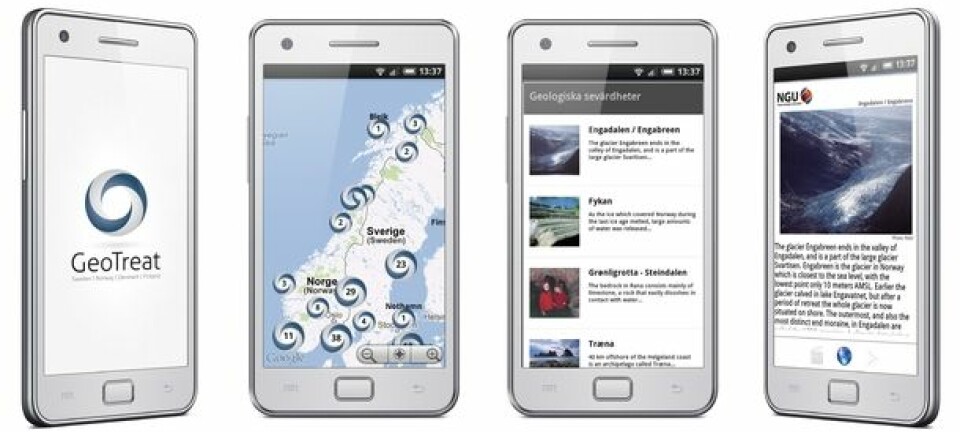
Geoscience goes down better without the jargon
A stone stemming from magma can be designated as igneous, but it could also be called spotted. A child might find learning geology as hard as a rock – given even a fraction of its formal terminology – or easy as pie if a few ordinary concepts are applied.
Denne artikkelen er over ti år gammel og kan inneholde utdatert informasjon.
After Merethe Frøyland completed her degree in geology she sometimes had to fight back her panic:
“Acquaintances came to me with rocks and asked what they were. They reckoned that as a geologist I would certainly know. But I didn’t!”
She had learned to classify rocks into three groups: igneous, metamorphic and sedimentary. Of course that was just a start. University lecturers kept students constantly steadily filling their notebooks with new, difficult terms, categories and subcategories ad infinitum. But where was the focus on how observations could be made in the field?
“I’d learned countless scientific terms at university. But they were of no use off campus and out in real nature.”

She and her husband Jørn Hurum, Norway’s best known palaeontologist, arrived at an idea:
Rocks could roughly be split into three groups, those that were spotted, those with curvy stripes and those that consist of layers (and sometimes reveal fossils).
The whole family goes to work
Frøyland works at the Norwegian Centre for Science Education at the University of Oslo. One of her tasks is to research new and better ways to teach the natural sciences to school children.
She decided to try out the new model in her daughter’s kindergarten, with the help of her mother and sister, both of whom work in kindergartens. How do you teach geological subjects to pre-schoolers, aged five and six?

They gave her a hint: Kids first have to understand and discern between patterns. This is part of kindergarten teaching.
Merethe’s mum and sister suggested she start by collecting a lot of everyday items. Things that were spotted or striped.
“I went to town on that and started gathering all sorts of things that were spotted or striped –cups and clothes that had various spots, in an array of sizes and colours.”
“Then I asked the kids what these objects had in common. They arrived at the fact that they were spotted or striped, yet still quite different.”
“Then I told them that this is how it is with rocks too. I asked them to go out and find spotted and striped rocks.”
This was the start of teaching model called The Budding Science and Literacy Project.
Rock hounds
Frøyland runs frequent courses for geoscience teachers. When she told them about the idea for this new teaching model, one teacher in particular found it captivating:
“When I heard about these spots and stripes I changed my perspective. I started looking down at the ground when out walking,” says educator Anne Cathrine Hammerborg of Berger School at Nesodden, a peninsula in the Oslo Fjord.
“I was eager to try it out on my class. We filled the classroom with rocks. First we sorted them: What is a spotted pattern? What is striped? It took off like a rocket. I had a class full of rock hounds and they wanted to construct volcano models and hunt for fossils all the time,” she says.
Hammerborg found out that it isn’t always so easy to identify rocks. Some were both spotted and striped. There are also sedimentary rocks like sandstones which might not have discernible layers.
“But we solved that one easily. We simply toss away such rocks and picked up new ones.”
She has tested the method on fifth graders and seventh graders with equal success.
Are you smarter than a second-grader?
The Norwegian Centre for Science Education at the University of Oslo has also run a researcher project for high schools.
“This gave us an idea. How much do high school students who have had traditional geology instruction know compared to our second-graders?”
Researchers presented the teenagers and the eight-year-olds with identical rock collections and asked them to classify the stones and justify their decisions.
The result was remarkable.
The high school students spent loads of time. They knew a lot of concepts but they were totally helpless when it came to identifying the rocks. They couldn’t apply their knowledge to the rocks at hand.
While almost none of the high school kids managed to sort the rocks properly, the second-graders did it in a half a minute without problems.
Less is more
Merethe Frøyland thinks that nature studies should be simplified as much as possible.
Scientific terminology and concepts are important. But most of these concepts are not so essential that they have to be learned straight off.
“It’s a question of finding out which ones, and cutting out the rest.”
--------
Read the Norwegian version of this article at forskning.no
Translated by: Glenn Ostling




































